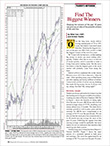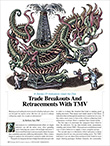LETTERS TO THE EDITOR
May 2012 Letters To The Editor
The editors of S&C invite readers to submit their opinions
and information on subjects relating to technical analysis and this magazine.
This column is our means of communication with our readers. Is there something
you would like to know more (or less) about? Tell us about it. Without a source
of new ideas and subjects coming from our readers, this magazine would not
exist.
Address your correspondence to: Editor, Stocks & Commodities,
4757 California Ave. SW, Seattle, WA 98116-4499, or E-mail to editor@traders.com.
All letters become the property of Technical Analysis, Inc. Letter-writers
must include their full name and address for verification. Letters may
be edited for length or clarity. The opinions expressed in this column do not
necessarily represent those of the magazine. —Editor
TECHNICAL & FUNDAMENTAL FILTERS
 Editor,
Editor,
I read Mike Carr & Amber Hestla’s March 2012 article in S&C, “Find The Biggest Winners,” which has the premise that studying the winners of the past 10 years can give you an idea of possible winners for the next five. Based on the article, just to clarify, should I be filtering on the following data points?
- Market cap less than 300 million
- Closing prices increasing during the last 12, 24, 36 and 40 months
- Positive earnings for the past four years
- 48-month moving average.
FRANK HOPKINS
Author Mike Carr replies:
There are a number of ways to screen for microcap stocks with strong potential for the long term. The market cap cutoff of $300 million could be raised or lowered to expand or limit the number of buy candidates. Positive earnings are a common factor in big winners from the past — investors want to see results in addition to potential.
A technical screen, such as MACD giving a buy signal, is helpful. That captures stocks moving higher, instead of buying value stocks that are declining toward possible problems. A long-term moving average filter serves the same purpose. It is important to find stocks that others are buying to avoid holding dead money in your investment account.
The requirement for higher prices in the various periods that you mention could serve this purpose.
THE PROBLEM WITH THE CLASSIC RSI FORMULA
Editor,
The RSI is a problematic indicator because the formula that J. Welles Wilder used to compute his exponential constant is not the same as the one commonly used by traders and system builders when constructing other indicators. I’ll explain why this is a problem.
But first, the “standard” EMA has this form: (2/(N+1))*(P-A)+A, where 2/(N+1) is the exponential constant, N = period, P = current price, and A = the previous bar’s EMA.
The EMA that Wilder uses for the RSI is: (1/N)*(P-A)+A. Note: This form is obtained by rearranging his better known form, which is (P+(N-1)*A)/N.
Its constant is 1/N. Both constants satisfy the “boundary condition” that the constant, whatever its form, must equal 1 when N=1. That is, a one-bar EMA equals the current price. There are an infinite number of formulas of this form that can be used that satisfy this boundary condition. Their general form is: (1+C)/(N+C), where C = 0,1,2,3,... to infinity. [When N=1, the ratio (that is, the EMA constant) always equals 1.]
However, the standard EMA uses C=1, while Wilder sets it to zero.
So which one should be used? The standard formula is used for computing price EMAs because when you compute a series of EMAs using C=0,1,2,3... for a given N period, you find that C=1 produces an EMA that is closer to the simple moving average of period N than any other C value.
Wilder’s constant causes a problem when you are trying to make your RSI fit a period that you see in the price action, or when you are trying to match the period of another indicator. Your period will always be off by about a factor of 2 — that is, a Wilder EMA of period 14 is actually a period of 27 [=14*2-1].
The stochastic RSI in particular is a mixed bag because if you use, for example, 14 for your period, the RSI period is actually 27 while the stochastic period is still 14. Now, it might be that this combination works well with your historical data, but you need to know what is really being computed.
The best way to fix this inconsistency between Wilder’s RSI and every other oscillator/price series would be to change Wilder’s EMA formula. However, there are so many canned RSI programs using it, that’s not likely to happen. Fortunately, you can adjust your RSI period to get the actual period you want, or close to it. The formula for this is: Wilder RSI period = (True period+1)/2. So if you want a true period of say, 21, add 1 and divide by 2, resulting in 11. Use 11 in the Wilder RSI formula.
John Leonatti
Uniontown, OH
JAMIE THEISS ARTICLES
 Editor,
Editor,
I really enjoy your magazine! As a new person to the frontier of daytrading, I would like to see more articles by Jamie Theiss. I relish how in every article Theiss is precise in illustrating specific setups for day trades. Although Theiss’ articles manage to convey the intricacies of daytrading, they can be comprehended as well. As a self-proclaimed newbie, I have found that each article has been enlightening and relevant to my learning about daytrading.
In your upcoming issues, please try to include more articles by Jamie Theiss or perhaps a full interview with him. I feel his knowledge and expertise in daytrading is invaluable to those of us who are new to daytrading.
Keisha Brooks
Thanks for writing and for your feedback. Readers may be interested in checking out some of Jamie Theiss’ past articles in Stocks & Commodities:
- “Gap Fill And Go” (May 2011)
- “Classic Short Sell Setup” (June 2011)
- “The V-Bottom Buy Setup” (August 2011)
- “Coach Yourself To Trading Success” (November 2011)
Subscribers can access our complete article archive online from our website, Traders.com. From our homepage, go to the “Complete Archive” area (click on “Enter now”). It will prompt you to log in, then you can browse by issue or use the search box. Articles are served as PDF files.—Editor
DOGS OF THE DOW
Editor,
The article “Don’t Ditch The Dogs Of The Dow” in your 2012 Bonus Issue has a good idea but one that over time doesn’t benefit the investor. Its concept makes sense on paper: don’t invest in stocks in a free fall at the end of the year. But it forgets the concept of the Dogs: the losers — that is, the Dow high-yielders — are already depressed and are more likely to rebound than the non-Dogs.
When the “Dogs” idea was first put forth, it had a reasonably good record. In the years since, its record has been spotty. Good ideas get arbitraged out of the market when they become known.
Looking at this system’s record, it would be hard to find an investor who would stick with it. From 2000 to 2005, an investor would have lost money, net. Who would stay with such a system? Six years? In 2006 the investor would have caught up with the original. The investor would have been even in 2007 and then would have begun to gain in the next four years. Four years out of 11? Very bad odds. A waste of readers’ time.
John R. McGinley
Editor, Technical Trends
TMV KELTNER CHANNEL PERIOD
 Editor,
Editor,
Thank you for publishing Barbara Star’s “Trade Breakouts And Retracements with TMV” in your February 2012 issue. In the test, she says she is using a 20-period Keltner channel, but it seems that her MetaStock code shows a period of 13. Which is the correct/preferred period?
Also, less important, using MetaStock (version 11), I cannot get the nice, solid multiday volume bars shown in Figure 1 of the article. Mine are single day with visible dots at the base for all other days. MetaStock support wasn’t able to help. Any suggestions?
Mike
Author Barbara Star replies:
I can understand your confusion. Let me begin with your second question, which involved the volume oscillator. The volume oscillator identifies volume spikes and appears in a narrow channel below the price chart. Both the colored bars and the volume oscillator are part of an expert advisor and not plotted in the indicator builder. You probably have already created the colored price bars, but for those readers who are less familiar with creating expert advisors in MetaStock, here are instructions for creating an expert advisor.
Select the expert advisor icon and press new. Click on the Highlight tab. Select New, give it a name, and type in the ADX price rising formula. Select a color and click OK. Create a second highlight by selecting New, give it a name, and type in the formula for ADX price falling. Select a color and click OK. You will now have the names of two formulas listed as highlights. If the small box next to the name is blank, click on it so it will be activated.
Then, within the same expert advisor, click on the Trends tab. In the bullish space, type in the formula given for the volume oscillator. Leave the bearish rectangle space blank. Click on Ribbon. Click “Display ribbon in chart.” Change the color in bullish to black. Under background, change the color in bearish to white. Change the color in neutral to white. Under pattern, use the down arrow to select “none” in all three boxes. Delete any labels. Click OK. This completes the expert advisor.
Once the Keltner channels and the CCI have been plotted on a price chart, select the expert advisor that was created and click on Attach. Close the expert advisor. If the image looks like the one in my article, then it can be saved as a template and applied to other charts.
Now, to return to your first question: Good observation about the code given for the Keltner channel formula. I included a set of code that at one time had used a default of 13 periods. However, that will not create a problem. You can add the MetaStock formula as presented on page 13 of the issue into the MetaStock indicator builder to save it. When you select it from the indicator quicklist, it will ask the number of periods you want. Just type in 20 and it will automatically produce the Keltner channel moving average periods used in my article. Feel free to experiment with other periods.
Let me remind readers that I used the original Keltner formula and not the modification created by Linda Raschke that many charting programs incorporate. If the program asks for the number of ATRs or the length of an exponential moving average, then it is not the same as the one I used in the article and will not produce the same charts.
If you run into any problems with the creation of the TMV, please feel free to email me at star4070@aol.com.
Thanks again for your questions and your interest in the TMV. I hope you find it useful in your trading.
ERRATA: CONTACT INFORMATION FOR MTPREDICTOR
Editor,
In your 2012 Bonus Issue, in the Readers’ Choice Awards section, it was great to see that we won an award. But please note you have listed an old email address and phone number. Our updated contact information is as follows:
Phone: +44 117 9854397
email: admin@MTPredictor.com
Steve Griffiths
Director, MTPredictor
Originally published in the May 2012 issue of Technical Analysis of Stocks & Commodities magazine. All rights reserved. © Copyright 2012, Technical Analysis, Inc.
Return to
Contents
 Editor,
Editor, Editor,
Editor, Editor,
Editor,